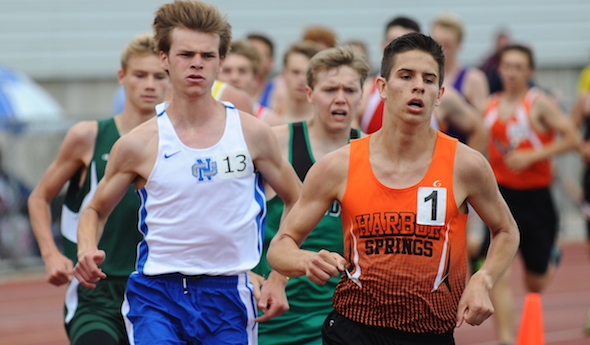
Kloss Raring to Make His Move in D3
April 20, 2018
By Dennis Chase
Special for Second Half
HARBOR SPRINGS – Jeremy Kloss is growing weary of northern Michigan’s cold, snowy spring.
 “I’m a little frustrated,” said the Harbor Springs junior, who won the 1,600 and 3,200 meters at last June’s MHSAA Lower Peninsula Division 4 Track & Field Finals. “I really want to get a meet in.”
“I’m a little frustrated,” said the Harbor Springs junior, who won the 1,600 and 3,200 meters at last June’s MHSAA Lower Peninsula Division 4 Track & Field Finals. “I really want to get a meet in.”
A mid-April snowstorm blasted the area with more than a foot of snow last weekend. Most schools were closed Monday – and some Tuesday.
Kloss used the extended weekend break to put in an eight-mile run – his longest of the year.
“I had to find roads that weren’t as snow-covered as others,” he said. “It wasn’t the best footing.”
No sport has been able to gain traction.
According to the National Weather Service in Gaylord, this is the coldest and snowiest April on record in the northern Lower Peninsula. Some 37.3 inches of snow has fallen in Gaylord this month, eclipsing the previous record of 27 inches in 1923. Traverse City has had 27.1 inches, surpassing the mark of 17.3 in 2007. In addition, the average daytime temperature has been running 18 degrees below normal in this part of the state.
Harbor Springs had its first three track meets cancelled or postponed. The weather is expected to start turning this weekend, so there is hope the season will get underway next week, about three weeks from Regionals.
“I looked on athletic.net and it appears most schools, even downstate, haven’t had too many meets,” said Mike Kloss, Jeremy’s father and the longtime Rams boys track coach. “That makes me feel a little better. If they’re running downstate, and you’re not, then you feel like you’re behind the 8 ball.
“The weather’s got to give us a break.”
Jeremy sure hopes so.
“I don’t know if my mom (Emily, the girls track coach) has taken the snow tires off her vehicle yet,” he said. “I haven’t taken the sand bags out of my truck.”
Once the season starts, Jeremy Kloss is hoping to build off last year’s accomplishments when he set personal bests in capturing the 1,600 (4:25.73) and 3,200 (9:46.25) at the Finals. He was also on the 3,200 relay team that took third and the 1,600 relay that placed seventh. That helped spark the Rams to a third-place team finish.
Kloss, whose three older brothers previously ran for the Rams, jokingly noted last June before the championship meet that his brothers always had one question for him – “Why aren’t you running faster?”
“If you’ve been around us, you know it’s not an easy crowd at times,” said Mike with a laugh.
The 17-year-old put that to rest and now owns bragging rights in the family with the fastest 1,600 and 3,200 times.
Now he’s hoping to keep dropping and challenge school marks in the 800 (Jacques Henning, 1:56.36), 1,600 (Tec Adams, 4:16) and 3,200 (Adams, 9:24).
“My goals are ambitious,” he said. “Aim high.”
“He’s self-motivated,” added his father. “Like (Monday), he went out and ran eight miles in crappy weather. He has big goals in what he wants to do, and that’s what drives him. He wants to be good. He works hard.”
Kloss finished second to Caro’s Yami Albrecht (15:44.7 to 15:47.1) at the LP Division 3 Cross Country Final in the fall. Then, for the most part, he put training on hold to play basketball during the winter.
“Toward the end of the (basketball) season I would wake up at 6 a.m. and run three times a week, and then on the other two mornings I would go to the gym with a couple buddies for workouts (before school),” he said.
All in hopes of getting off to a fast start in track.
Then, Mother Nature intervened.
 Kloss is motivated since he’ll have to now prove himself in Division 3.
Kloss is motivated since he’ll have to now prove himself in Division 3.
“There’s a really good group of (distance runners) in Division 3,” he said. “It’s a tough group to hop in with, but I’m looking forward to the challenge.”
The field includes Albrecht, Hanover-Horton’s Landon Melling, Cass City’s CarLee Stimpfel, Saugatuck’s Corey Gorgas and Kent City’s Fraser Wilson. Gorgas was second (9:20.16), Stimpfel third (9:30.77) and Wilson fourth (9:36.23) in the Division 3 3,200 last June. In the 1,600, Melling finished second (4:17.04), Albrecht third (4:18.49), and Stimpfel fourth (4:19.55).
“That 9:20 Corey (Gorgas) ran in the 3,200 is fast, and I think he ran that fast indoors (over the winter),” said Mike Kloss. “D-3 is a lot different. In D-4 you might have one or two (vying for the title), but in D-3 you’ll have five or six. It’s another challenge, another step.”
In D-4 a year ago, Kloss won the 1,600 by nearly three seconds and the 3,200 by nearly eight.
“I think Jeremy could have gone 4:20 (in the 1,600) in the right type race,” said his father.
East Jordan coach Matt Peterson agrees that Kloss will face a stiffer challenge in Division 3.
“The times will be quicker and the fields will be deeper,“ he said. “But having said that, he was close to winning the D-3 cross country title. It wouldn’t surprise me if he placed very well or won at the state track meet.
“It goes back to his persistence. That’s the one word I would use to describe him. I’ve seen him run since middle school and I’ve never seen him run what I consider a bad race. I’ve never seen him mentally quit in a race, no matter how he feels. Every runner has an off day where they don’t feel right. He runs through that. That’s huge in anything, including life.”
Peterson and Mike Kloss were college teammates at Ferris State in the mid-1980s. He’s watched Jeremy grow up, starting when Jeremy was just weeks old and his parents brought him along to the state cross country meet.
“He’s a nice kid,” said Peterson. “I’ve watched him run at numerous state meets and the way he conducts himself, his attitude, is unbelievable. I was at the D-4 track meet last spring, and after he won the 3,200 he ran across the track and hugged me – and I’m an opposing coach. I can’t say enough good things about him.”
Mike Kloss will let the next few weeks play out to see what events Jeremy will run come Regionals and, most likely, the Division 3 Finals.
“It’s way too early to make those decisions,” Mike said.
Jeremy, meanwhile, is excited to see what the 3,200 relay can do. Senior Max Sydow and sophomore David Harrell return from a unit that posted a podium finish last year. Sophomore Austin Smar will join the mix.
“If we all drop our times, which I think we can, we can be pretty good,” Jeremy Kloss said.
It will be an important few weeks for Kloss as he also tries to showcase his talents for college coaches. He’s received attention from some Division I schools outside the state, although his preference is to remain in-state.
“I would like to be closer to home,” he said.
For Mike and Emily Kloss, this is their 28th year coaching in the Harbor Springs system. They also lead the cross country programs. Mike recently celebrated his 30th anniversary with the Michigan State Police. Most of those years were spent working the nightshift. Now, he’s working days as a court officer.
His training regimen for distance runners is based on low mileage, high intensity workouts.
“It’s not that we went in with that thought,” he said. “We adapted to it. If I ran kids big miles, we would lose them and we don’t have many spares.
“Jeremy has been gradually increasing (his miles), but I don’t want him to run college workouts in high school. It seems to be working for him.”
Jeremy said there’s another benefit to lower mileage.
“Kids are not getting hurt,” he said. “I can’t remember anyone having a stress fracture. The closest thing we’ve had is a couple kids with shin splints for a week or so. We’re staying healthy.”
As a trade-off, runners are asked to test themselves when they do work out.
“My dad likes to say, ‘A little faster if you can stand it,’” Jeremy said. “We have that quote on our sweatshirts and T-shirts.”
Now, if they just had better weather to start applying it.
 Dennis Chase worked 32 years as a sportswriter at the Traverse City Record-Eagle, including as sports editor from 2000-14. He can be reached at [email protected] with story ideas for Manistee, Wexford, Missaukee, Roscommon, Ogemaw, Iosco, Alcona, Oscoda, Crawford, Kalkaska, Grand Traverse, Benzie, Leelanau, Antrim, Otsego, Montmorency, Alpena, Presque Isle, Cheboygan, Charlevoix and Emmet counties.
Dennis Chase worked 32 years as a sportswriter at the Traverse City Record-Eagle, including as sports editor from 2000-14. He can be reached at [email protected] with story ideas for Manistee, Wexford, Missaukee, Roscommon, Ogemaw, Iosco, Alcona, Oscoda, Crawford, Kalkaska, Grand Traverse, Benzie, Leelanau, Antrim, Otsego, Montmorency, Alpena, Presque Isle, Cheboygan, Charlevoix and Emmet counties.
PHOTOS: (Top) Harbor Springs’ Jeremy Kloss leads the pack during last season’s 1,600 championship race at the LP Division 4 Finals. (Middle) Kloss crosses first to win the 3,200 title. (Click for more from RunMichigan.com.)
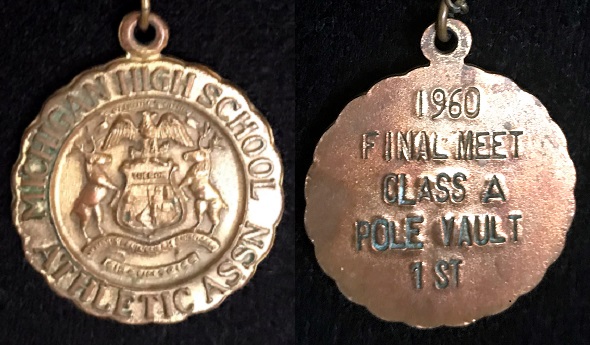
60 Years Later, Co-Champ Rediscovered
March 25, 2020
By Ron Pesch
Special for Second Half
Nicholas “Mickey” Turcheck tells a wild story. It involves a coin flip.
Involved in track & field for much of his life, Turcheck was a pole vaulter at Taylor Center during his high school days, then at Western Michigan University. He later served Taylor Center for more than three decades as track coach, where he mentored five state champions.
He also coached two future Olympians. Earl Jones, who won MHSAA Finals track titles in both 1980 and 1981, and grabbed bronze in the 800 meters at the 1984 Summer Olympics in Los Angeles. Another of his athletes, Deby LaPlante, qualified for the 1976 Summer Olympics in Montreal as a high hurdler.
In Turcheck’s possession is a medal. Etched on the back, pounded out in the style of the time, are five lines.
1960
FINAL MEET
CLASS A
POLE VAULT
1ST
Those 31 characters honor his MHSAA championship performance on what became a windy day in Ann Arbor at University of Michigan’s old Ferry Field.
But there is one problem. Turcheck’s name doesn’t appear on the MHSAA list of Finals champions. According to the list, the championship belongs to Joe Baldy of Monroe.
(The list has since been corrected and amended, per the story to be told below.)
Trackheads
For ‘trackheads’ – diehard fans of the sport and the events that comprise a track meet – as well as sports historians, a newspaper’s agate page is nirvana. Contained within the tiny type are the details that aren’t always relayed within the article covering a sporting event. Things like baseball batting averages, league standings, box scores, stat lines, team transactions, TV and radio schedules, and most everything else that doesn’t fix conveniently into the day’s sports section might appear on the page. For a track meet, a full agate listing will include place finishes as well as times, heights and distances that were used to determine winners of events, as well as detail on record performances that were equaled or topped.
Jim Moyes is a passionate sports fan. An undersized high school athlete at a small school, where participants of all shapes and sizes are valued, Moyes was the son of a prep coach at North Muskegon High School. He grew up and became, among other things, a beloved and respected broadcaster and public address announcer. Few were as well-prepared as Moyes, who studied agate pages, past performances, and, it seemed, the family trees of the participants prior to sitting before a microphone. His knowledge, as well as his sense of humor, was on display for 43 years in West Michigan, where he would balance his understanding and importance of an event with the awareness that, in the end, what we were experiencing was still just a game.
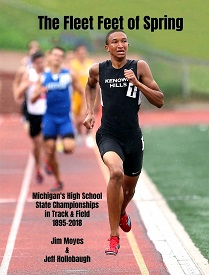 Well over 30 years ago he began his research into a passion project. Moyes is a ‘trackhead.’ And, because of this, in 2019, he officially became the author of a published book.
Well over 30 years ago he began his research into a passion project. Moyes is a ‘trackhead.’ And, because of this, in 2019, he officially became the author of a published book.
Way back, Moyes began digging into microfilm with the goal of capturing the names and events behind each MHSAA Finals track championship. He shared his initial research with the MHSAA, and for years the Association has highlighted his work on its website with lists of individual state champions on both their boys and girls track pages.
A couple of years before wrapping up his research, Moyes began work with another certified ‘trackhead,’ Jeff Hollobaugh – associated editor of Track & Field News, the voice of countless track meets, and as Moyes states, an “expert on this great sport” – to tell the stories of the meets in book form. “The Fleet Feet of Spring” – a history of Michigan’s High School State Championships covering the span 1895-2018 – was the result.
That’s 24,446 state champions. Simply put, its 439 pages contain a marvelous collection of statistics, stories and images.
But, with good reason, Turcheck’s name doesn’t appear in the publication.
Golden Age of Newspapers
Post-event press coverage on the 1960 MHSAA State Track Meet for most readers across Michigan arrived in their newspaper courtesy of coverage by wire-service reporters from The Associated Press or United Press International. With four meets to cover that encompass hundreds of prep athletes, the arch of the stories generally focus on record-setting events and streaks of success.
In Class A, the story was focused on the Pontiac Central squad that slipped past Flint Northern, 44-41, for its fifth title in six years. It was the seventh year in a row that the Vikings finished second at the meet. Pontiac junior Bredell Pritchett’s 59-foot-5¾ toss of the shot exceeded the previous state mark by better than two feet. Northern’s Maurice Pea, clocked at 9.8 seconds, tied a 35-year-old mark in the 100-yard dash. Al Ammerman of Dearborn established a new high jump record.
In 1960, the details of the pole vault simply weren’t the story.
Available space in newspapers is dictated by advertising. That certainly is the case today, and was most certainly the case back in the glory days of newsprint. Decisions are made by sports editors and staff on the amount of space available, and what agate will be printed. The results of a track meet, let alone the four simultaneous meets that comprise the MHSAA state championships, can certainly eat up plenty of real estate.
Relatively few papers around Michigan dedicated space to the MHSAA Track Championships back in May 1960. The old Detroit Times is among those that did include agate. Study of the listing however provides little clarity, as the paper listed only Metro Detroit finishers beyond the event winners. For the pole vault, that means confusion.
Pole Vault – “1 Joe Baldy, Monroe: Mickey Turcheck. Taylor Center: Bob Davis. Redford Union. and Larry Richardson. Livonia Bentley. were among those tieing for fourth. Distance 12 feet, 9 inches.”
The Grand Rapids Press agate adds haze to the mix. Baldy is listed in first, but Turcheck is listed as finishing second, followed by Flint Northern’s Jerry Wright in third. Davis, Richardson, Mike Pedler of Muskegon, J. Best from Battle Creek Central and Bill King of Traverse City are listed as occupying fourth place
The Battle Creek Enquirer lists only Baldy as the winner of the event and John Best “tied for fourth.” The Lansing State Journal agate shows only Baldy as the event winner. No track agate appears in the Detroit Free Press. Although the paper notes that team-wise, Birmingham finished third with 18 points, followed by Dearborn, Ann Arbor, Muskegon and Saginaw Arthur Hill in its coverage, the results from the Class A pole vault are not mentioned.
The Traverse City Record-Eagle does not include agate, but the article notes King’s fourth place finish, and that the Trojans track team spent the night sleeping on tumbling mats in the Saginaw Arthur Hill gymnasium when its bus broke down on the return trip home from Ann Arbor.
So, with little surprise, Moyes’ research concluded Baldy was the 1960 Class A pole vault champion.
Story of the Medal
In early March, Tony Mifsud, a longtime track coach at Dearborn Divine Child, contacted MHSAA Director of Broadcast Properties John Johnson about the story.
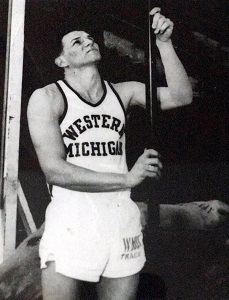
Turcheck was recently visiting a friend, Bob Parks, the head track coach at Eastern Michigan University for 34 years and an assistant track coach at Western Michigan during Turcheck’s time in Kalamazoo competing for the Broncos. On a visit this past fall, Parks mentioned the Moyes and Hollobaugh book that he had recently received.
“Mick, your name is not listed there,” said Parks. “I know you were tied for the state championship because I was the coach at Redford Thurston at that time and I was at the state meet. I remember you being announced as the co-state champion of the pole vault.”
“I said, ‘Really?’” recalled Turcheck from his home in Taylor.
After the visit, he made a couple of phone calls to friends. In turn, some of those folks began reaching out to others with the story.
According to Turcheck, after the pole vault was over, a meet official said they only had one medal and they were going to flip to determine who would receive it. Turcheck won the coin flip and was awarded the souvenir. A duplicate medal was to be mailed to his co-champion.
Newsprint and the Miracle of Microfilm
Before the days of smartphones, e-mail, websites, pop-up ads, and cloud storage, the history of cities, big and small, was captured in print and sold on street corners, at newsstands, and, beginning in 1947, by coin-operated vending machines.
Monthly subscriptions meant home delivery of the day’s news, and newspapers were everywhere.
Before Craigslist and Google Ads, there was money to be made in helping businesses advertise their wares, employers to advertise job openings, and for individuals to sell items and offer apartments for rent in the classifieds. That strong revenue stream supported large staffs and solid coverage of local events at daily and weekly newspapers.
Some of that content – that history – is slowly coming online, but most of it remains tucked away on microfilm and microfiche in local libraries across America.
And sometimes, local pride resulted in details about the exploits and accomplishments of area athletes to appear in smaller town publications that cannot be found elsewhere.
Niles Kruger, a sportswriter at the Monroe Evening News, followed up on a request by Johnson to check microfilm from newspapers in the area for any detail that might exist. Fortunately, the coverage in the Evening News appears to help clear up much of the story.
The article also illustrates an issue often injected upon microfilm by small agate-style typeface. Characters can often bleed or blur and appear to be other letters. A lower case ‘s’ can look like an ‘a’ or an ‘e’; a lower case ‘i’ can look like lower case ‘l.’ Unexpectedly, this, too, was illustrated here.
And sometimes, long lists are subject to other errors.
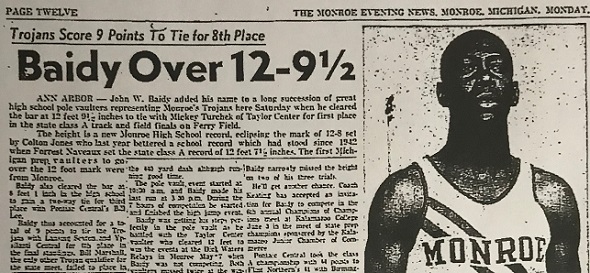
‘Baidy’ not ‘Baldy, ‘John’, not ‘Joe’
“ANN ARBOR - John W. Baidy added his name to a long succession of great high school pole vaulters representing Monroe’s Trojans here Saturday,” stated the Evening News, “when he cleared the bar at 12 feet 9 ½ inches to tie with Mickey Turcheck of Taylor Center for first place in the state Class A track and field finals on Ferry Field …”
“Baidy also cleared the bar at 6 feet 1 inch in the high (jump) to gain a two-way tie for third place with Pontiac Central’s Bill Lee. Baidy thus accounted for a total of 9 points to tie the Trojans with Lansing Sexton and Ypsilanti Central for 8th place in the final standings.”
While there is no mention of the flip for the metal, the article backs up Turcheck’s recall of the day.
Recognizing that despite their best efforts, Moyes and Hollobaugh know that errors can appear in the publication. In their “Notes to the reader” section, they ask readers to please make contact if any mistakes are spotted.
“Thanks to today's modern technology Jeff Hollobaugh will be able to make the appropriate corrections in our book” noted Moyes from Florida via email, noting the marvels of the times we live in. “Better yet for Jeff & I,” added Moyes, displaying his comedic style, “with the amended corrections maybe Mickey Turcheck will purchase our newly revised book.”
Search for Baidy
“They wanted to flip a coin,” said Baidy recently, surprised in the sudden interest in a day from so many years ago and chuckling at the memory. “He got the call and got the medal. I really don’t remember if they told me if I was supposed to get a medal (in the mail). Right after that I had to go to the high jump or something.”
Baidy – who also tied for the Class A Finals high jump championship in 1959 – had received a call earlier on this day from his long-ago opponent from Taylor Center.
“I would certainly like to meet him again,” said Turcheck. His former high school sweetheart and bride had used her smartphone to seek out Baidy’s contact information, and soon after, the two old athletes were reminiscing about the day. Turcheck pitched the idea of getting together for lunch or dinner sometime soon.
“That’s what he wants to do, and it’s all right with me,” Baidy said, noting plans after things settle down. “We’re lucky to still be alive.”
 Ron Pesch has taken an active role in researching the history of MHSAA events since 1985 and began writing for MHSAA Finals programs in 1986, adding additional features and "flashbacks" in 1992. He inherited the title of MHSAA historian from the late Dick Kishpaugh following the 1993-94 school year, and resides in Muskegon. Contact him at [email protected]:void(0);t with ideas for historical articles.
Ron Pesch has taken an active role in researching the history of MHSAA events since 1985 and began writing for MHSAA Finals programs in 1986, adding additional features and "flashbacks" in 1992. He inherited the title of MHSAA historian from the late Dick Kishpaugh following the 1993-94 school year, and resides in Muskegon. Contact him at [email protected]:void(0);t with ideas for historical articles.
PHOTOS: (Top) The 1960 Finals championship medal, front and back, awarded to Baidy. (2) The Fleet Feet of Spring has been revised based on the latest re-discovery of a co-championship. (3) Mickey Turchek went on to compete at Western Michigan. (4) The Monroe Evening News announced John Baidy’s championship pole vault as part of its coverage of the 1960 Class A Track & Field Finals. (Turchek photo courtesy of the Turcheck famly; newspaper clipping courtesy of the Monroe Evening News.)

